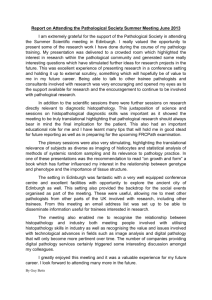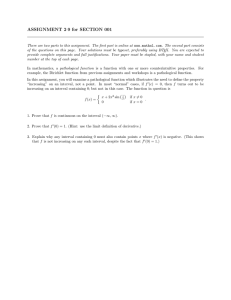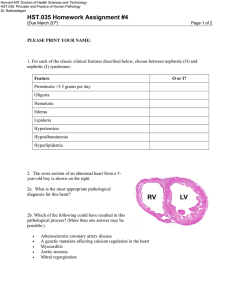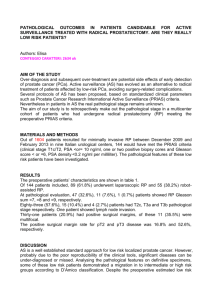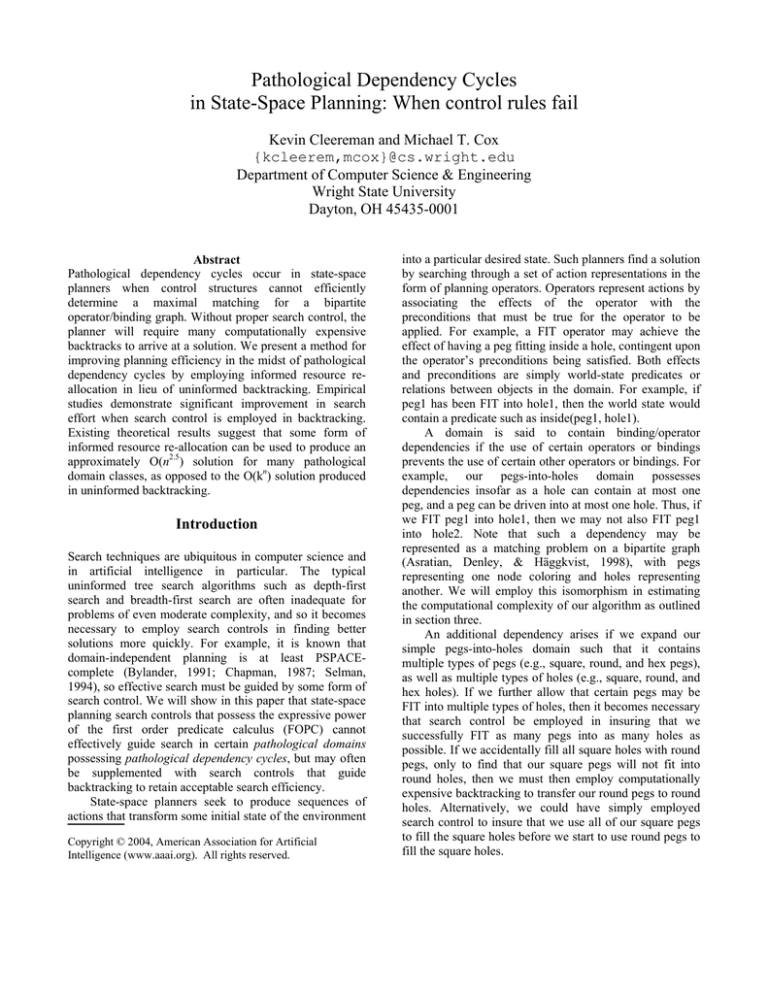
Pathological Dependency Cycles
in State-Space Planning: When control rules fail
Kevin Cleereman and Michael T. Cox
{kcleerem,mcox}@cs.wright.edu
Department of Computer Science & Engineering
Wright State University
Dayton, OH 45435-0001
Abstract
Pathological dependency cycles occur in state-space
planners when control structures cannot efficiently
determine a maximal matching for a bipartite
operator/binding graph. Without proper search control, the
planner will require many computationally expensive
backtracks to arrive at a solution. We present a method for
improving planning efficiency in the midst of pathological
dependency cycles by employing informed resource reallocation in lieu of uninformed backtracking. Empirical
studies demonstrate significant improvement in search
effort when search control is employed in backtracking.
Existing theoretical results suggest that some form of
informed resource re-allocation can be used to produce an
approximately O(n2.5) solution for many pathological
domain classes, as opposed to the O(kn) solution produced
in uninformed backtracking.
Introduction
Search techniques are ubiquitous in computer science and
in artificial intelligence in particular. The typical
uninformed tree search algorithms such as depth-first
search and breadth-first search are often inadequate for
problems of even moderate complexity, and so it becomes
necessary to employ search controls in finding better
solutions more quickly. For example, it is known that
domain-independent planning is at least PSPACEcomplete (Bylander, 1991; Chapman, 1987; Selman,
1994), so effective search must be guided by some form of
search control. We will show in this paper that state-space
planning search controls that possess the expressive power
of the first order predicate calculus (FOPC) cannot
effectively guide search in certain pathological domains
possessing pathological dependency cycles, but may often
be supplemented with search controls that guide
backtracking to retain acceptable search efficiency.
State-space planners seek to produce sequences of
actions that transform some initial state of the environment
Copyright © 2004, American Association for Artificial
Intelligence (www.aaai.org). All rights reserved.
into a particular desired state. Such planners find a solution
by searching through a set of action representations in the
form of planning operators. Operators represent actions by
associating the effects of the operator with the
preconditions that must be true for the operator to be
applied. For example, a FIT operator may achieve the
effect of having a peg fitting inside a hole, contingent upon
the operator’s preconditions being satisfied. Both effects
and preconditions are simply world-state predicates or
relations between objects in the domain. For example, if
peg1 has been FIT into hole1, then the world state would
contain a predicate such as inside(peg1, hole1).
A domain is said to contain binding/operator
dependencies if the use of certain operators or bindings
prevents the use of certain other operators or bindings. For
example, our pegs-into-holes domain possesses
dependencies insofar as a hole can contain at most one
peg, and a peg can be driven into at most one hole. Thus, if
we FIT peg1 into hole1, then we may not also FIT peg1
into hole2. Note that such a dependency may be
represented as a matching problem on a bipartite graph
(Asratian, Denley, & Häggkvist, 1998), with pegs
representing one node coloring and holes representing
another. We will employ this isomorphism in estimating
the computational complexity of our algorithm as outlined
in section three.
An additional dependency arises if we expand our
simple pegs-into-holes domain such that it contains
multiple types of pegs (e.g., square, round, and hex pegs),
as well as multiple types of holes (e.g., square, round, and
hex holes). If we further allow that certain pegs may be
FIT into multiple types of holes, then it becomes necessary
that search control be employed in insuring that we
successfully FIT as many pegs into as many holes as
possible. If we accidentally fill all square holes with round
pegs, only to find that our square pegs will not fit into
round holes, then we must then employ computationally
expensive backtracking to transfer our round pegs to round
holes. Alternatively, we could have simply employed
search control to insure that we use all of our square pegs
to fill the square holes before we start to use round pegs to
fill the square holes.
The problem that we confront in this paper relates to
sets of domain rules whose graphical representation
contains cycles1. Such pathological dependencies prevent
efficient solutions during search for a plan. In the next
section, we examine the problem of using search control in
a domain containing a pathological dependency cycle.
Section three proposes a solution to the problem examined
in section two, and section four presents the empirical
results of our solution’s application. Finally, we conclude
this paper with discussion and a roadmap for future
research.
This domain contains three different TRUCK types,
each capable of loading a single object from a list of two
PACKAGE types. In turn, each of the three different
PACKAGE types is capable of being loaded onto a single
truck from a list of two TRUCK types. In Figure 1, we
represent this domain as a bipartite graph. Because there is
a 1-to-1 correspondence (that can be generalized to an Nto-M correspondence) between Trucks and Objects, a
planner will require some means of performing maximum
matching between Trucks and Objects to effectively
implement this domain.2
Pathological Domains
LOAD-FREEZER TRK
The standard logistics (or package delivery) domain
(Veloso, 1994) is used by many researchers who study
planning. This domain models the transfer of objects and
vehicles between various locations. Its basic operations are
as follows.
DRIVE (loc1, loc2) – transfers a vehicle and its contexts
from loc1 to loc2
LOAD (obj1) – loads an object of type obj1 onto a vehicle
UNLOAD (obj1) – unloads an object of type obj1
The preconditions for these operators are fairly
intuitive. For example, to unload an object from a vehicle,
the object must first be inside the vehicle (i.e., it must have
been loaded), and to load an object into a vehicle both the
object and vehicle must be at the same location.
We modified the basic logistics domain to create what
we call the Pathological Logistics Domain. The purpose of
this domain is to demonstrate the ineffectiveness of search
control under certain conditions and to examine alternate
control mechanisms. In this new domain, we specified that
every truck could load only one object per problem, and
every operator-binding match carried an equal utility
(every graph edge had an equal weight).
For testing purposes, we implemented in Allegro
Common Lisp 6.2 using CLOS (Common Lisp Object
System) a multiple inheritance version (dubbed Sprodigy)
of a state-space non-linear planning and learning
architecture called PRODIGY (Carbonell, et al, 1992;
Veloso, et al, 1995). The Object System’s built-in multiple
inheritance hierarchy allowed us to write a compact
pathological domain containing only three operators.
Meat
Produce
Figure 1. Pathological dependencies.
In general, a domain will be pathological if it contains
a set of cyclic operators:
1 ≤ i ≤ N, N ≥ 2,
Opi <vi> (OR(ti t(i mod N) + 1))
Problem solving in PRODIGY is performed by
means-end analysis, in which a goal is picked that is not
yet satisfied and an attempt is made to find an operator to
satisfy it. The open preconditions of this operator become
sub-goals, and the process is repeated until all goals are
attached to operators or are satisfied. The PRODIGY
decision cycle has four decision points that can be
heuristically manipulated by the application of control
rules.
1.
2.
3.
4.
2
For example, a domain wherein square pegs can be driven into
square or round holes, round pegs can be driven into round or hex
holes, and hex pegs can be driven into hex or square holes.
Dairy
LOAD-STD TRK
LOAD-FREEZER_TRK (OR(Meat, Dairy))
LOAD-REFRIG_TRK (OR(Dairy, Produce))
LOAD-STD_TRK (OR(Produce, Meat))
1
LOAD-REFRIG TRK
Given a list of pending goals, the system decides
which goal to pursue next.
Given a goal, it decides with which operator it will try
to achieve the goal.
Given an operator, it decides with what variablebindings it will instantiate the operator.
Given instantiated operators with no open
preconditions and a list of pending goals, it decides
whether to apply an operator and hence change the
current state, or whether to choose a pending goal to
solve.
We did not examine the more complex problem of finding a
stable matching on a bipartite graph with weighted edges, which
is analogous to a domain implementation containing inferential
goal transformations (Cox and Veloso, 1998). However, the
principle of the stable matching problem is identical to that of the
maximum matching problem.
When PRODIGY applies an instantiated operator in
decision number four above, an action's effects are
projected from the current state. Although backtracking
may reverse this decision, a final plan will consist of a
sequence of these operator applications.
As shown in Table 1, we attempt to improve planning
efficiency with control rules that order the goal/operator
selection process (decision points 1 and 2 above). No welldefined entry point for the graph exists, so we arbitrarily
choose our starting point at the Is-Loaded(Meat) goal.
1
2
3
4
5
6
Table 1. Pathological control rule set
if candidate-goal(Is-Loaded(Meat)) &
candidate-goal(Is-Loaded(Dairy))
then prefer goal Is-Loaded(Meat)
if candidate-goal(Is-Loaded(Meat)) &
candidate-goal(Is-Loaded(Produce))
then prefer goal Is-Loaded(Meat))
if candidate-goal(Is-Loaded(Dairy)) &
candidate-goal(Is-Loaded(Produce))
then prefer goal Is-Loaded(Dairy)
if current-goal(Is-Loaded(Meat)) &
candidate-op(LOAD-FREEZER_TRK)
then select op LOAD-FREEZER_TRK
if current-goal(Is-Loaded(Dairy)) &
candidate-op(LOAD-FREEZER_TRK)
then select op LOAD-FREEZER_TRK
if current-goal(Is-Loaded(Produce)) &
candidate-op(LOAD-REFRIG_TRK)
then select op LOAD-REFRIG_TRK
Unfortunately, this is a Pathological Domain. It
contains one pathological dependency cycle (though in
general, a Pathological Domain can contain any number of
dependency cycles). When a pathological dependency
cycle exists in a domain, then for any arbitrary set of
FOPC control structures we can nevertheless generate a
problem that will require backtracking.
For example, even when we employ our logistics
control rules in the Pathological Logistics Domain,
backtracking is needed to solve the problem with 2
Freezer_Trks, 1 Refrig_Trk, 3 Std_Trks, 2 Meat objects, 2
Dairy objects, and 2 Produce objects. In the initial state, all
Truck and Food objects are at the same location. The goal
is to Load all of the Food objects.
First, all Is-Loaded(Meat) goals are achieved (controlrules {1,2}) using up all Freezer_Trk resources (controlrule {4}). The planner then attempts to achieve all goals IsLoaded(Dairy) (control-rule {3}), but there are insufficient
resources for achieving this. Thus, the planner must
backtrack to use a Std_Trk vehicle in achieving a goal IsLoaded(Meat) so that a Freezer_Trk vehicle can be reallocated to achieving a goal Is-Loaded(Dairy).
It is important to realize that no given set of control
rules will be able to efficiently solve all problems in this
domain. If the control rules are re-ordered, then the
numbers of instances in the problem above can be
similarly re-ordered to defeat the new set of control rules.
An Algorithm for Resource Reallocation
Our solution to this problem is to employ directed resource
reallocation to improve backtracking efficiency. Presently,
this essentially amounts to the use of control rules during
backtracking. Given the problem example above, planning
proceeds as usual. However, when the planner finds that
insufficient carriers exist to solve all Is-Loaded(Dairy)
goals, it does not immediately close the search node.
Instead, it searches the problem-space for alternative
bindings that it can employ in achieving the remaining
goals Is-Loaded(Dairy) and then attempts to re-allocate
those resources.
In this particular example, the planner attempts to free
an instance of {Freezer_Trk, Refrig_Trk} to achieve IsLoaded(Dairy). There are no instances of Refrig_Trk that
are not already being employed in achieving goals of the
type Is-Loaded(Dairy), but there are instances of
Freezer_Trk that are not being employed in achieving
goals of the type Is-Loaded(Dairy). The planner attempts
to find operator/binding alternatives to an instance of
Freezer_Trk, and finds that there is a free instance of
Std_Trk that it can use in lieu of an instance of
Freezer_Trk in achieving one of the instances of IsLoaded(Meat). It de-allocates an instance of Freezer_Trk,
uses the alternative binding Std_Trk to achieve the
relevant instance of Is-Loaded(Meat), and re-allocates the
freed instance of Freezer_Trk to achieve the unsolved goal
Is-Loaded(Dairy). Ordinarily a planner will try all possible
combinations of Freezer_Trk and Refrig_Trk in achieving
goals Is-Loaded(Meat) and Is-Loaded(Dairy) before it
exhausts its alternatives and employs Std_Trk in achieving
goal Is-Loaded(Meat). Directed resource re-allocation
bypasses this exhaustive and expensive search process
using two basic functions called expand and de-allocate.
Expand
The expand function proceeds as follows.
(EXPAND node
if unallocated binding exists then
select binding
else if allocated binding exists and
(DE-ALLOCATE binding) then
select binding
else
no plan)
If an unallocated binding exists, then the search
proceeds as normal. If no unallocated bindings exist but an
allocated binding may be de-allocated, then the allocated
binding is de-allocated and used as if it were unallocated.
A binding is “allocated” if it is already maximally bound.
In the Pathological Logistics Domain, a truck can be used
in a single LOAD binding before it is allocated, but in the
general case an object can be used in N bindings before it
is allocated.
The only allocated bindings considered are those of a
different “kind,” e.g., if a Carrier binding is needed for an
Is-Loaded(Meat) goal then the algorithm will not DEALLOCATE bindings already bound by an IsLoaded(Meat) goal. This amounts to the use of control
rules during backtracking, though we are researching the
possibilities of employing a domain-independent definition
of “kind.”
De-Allocate
The de-allocate function proceeds as follows.
(DE-ALLOCATE binding
if binding is currently being DE-ALLOCATED then
return nil
else if unallocated alternate-binding exists then
de-select binding
select alternate-binding
return t
else if allocated alternate-binding exists and
(DE-ALLOCATE alternate-binding) then
de-select binding
select alternate-binding
return t
else
return nil)
If a binding is already being DE-ALLOCATED by a
function call on the stack, then it will not be DEALLOCATED a second time. This avoids infinite deallocation loops.
If a binding is de-selected, then the appropriate
binding-node is closed, and the alternate-binding is then
selected by the parent node. This is sufficient for a simple
domain like the Pathological Logistics Domain, but we are
examining the possibilities of this causing unintended sideeffects in a more complex domain.
This algorithm is similar to the double-looping
structure used in Hopcroft and Karp’s bipartite matching
algorithm (Hopcroft and Karp, 1973), which runs in
O(n2.5). (Further research is needed to determine if our
solution fully matches this performance, but given
Hopcroft and Karp’s results we expect that a polynomial
time algorithm exists that will efficiently solve all binding
problems that can be represented as a bipartite matching
problem, regardless of whether the domain is nonpathological or pathological.) Hopcroft and Karp’s
algorithm searches for an augmenting path for a given nonmaximal matching, whereas PRODIGY’s default search
strategy may destroy large sections of the current matching
path during the backtracking process. In terms of search,
goal-directed backtracking will only close a node after a
meta-search determines that the node can never be
expanded, thus insuring that minimal destruction is
performed on the search tree. In contrast, PRODIGY may
close large sections of the search tree during backtracking,
which often leads to the inadvertent destruction of many
useful search nodes that will merely have to be reexpanded later.
Though a polynomial-time solution to searching the
Pathological Logistics Domain exists, it is known that the
3-Color Bipartite Matching problem (being reducible to
the problem of partitioning a graph into triangles) is NPComplete (Garey and Johnson, 1979). This means that a
modified Logistics domain that must match Drivers to
Trucks, Trucks to Packages, and Drivers to Packages3 may
not have an efficient solution through directed
backtracking. We examine the ramifications of this
problem in our conclusion, but note that the problem is not
fundamentally altered if the choice of Driver does not
interfere with the choice of Package and vice versa, since
said domain’s graph representation would still possess
only two colors.
Empirical Results
We ran tests on three different i-Pack4 domains: the 3-Pack
domain, the 4-Pack domain, and the 5-Pack domain (see
Figures 2, 3, and 4 respectively). The 3-Pack domain is
equivalent to the domain described in the Pathological
Domain section, the 4-Pack domain contains an additional
Load operator (for a total of 4), an additional vehicle type
(for a total of 4), and an additional object type (for a total
of 4), while the 5-Pack domain contained 5 Load
operators, 5 vehicle types, and 5 object types. Each domain
is represented by a 2-regular bipartite graph, with vehicle
types and object types respectively composing the two
colors.
The domains did not contain any control rules, but
instead used Prodigy 4.0’s Random-Behavior flag to vary
the planning decisions. That is, PRODIGY normally
chooses equal decision alternates (i.e., those without
control rule guidance) at each of its four decision points in
a left to right order within the search tree. The flag
imposes an arbitrary order instead.
The test results are on the x1, x2, x3, and x4 problems,
where x1 denotes that the problem contained one object of
each Food type and one vehicle of each Truck type, x2
denotes that the problem contained two objects of each
Food type and two vehicles of each Truck type, and so
forth. The initial state for each problem placed all Truck
3
Perhaps some Drivers have an aversion to transporting Produce,
for example.
4
With apologies to Hewlett Packard.
Nodes ( Log10 )
5
4.5
4
3.5
3
2.5
2
1.5
1
0.5
0
Directed
Default
Cutoff
x1
x2
x3
x4
Nodes ( Log10 )
Figure 2. Search effort as a function of the number of
object instances in the 3-Pack domain
5
4.5
4
3.5
3
2.5
2
1.5
1
0.5
0
Directed
Default
Cutoff
x1
x2
x3
x4
Figure 3. Search effort as a function of the number of
object instances in the 4-Pack domain
Nodes ( Log10 )
and Food objects at the Start location, and the goal state
for each problem was to place all Food objects at the
Destination location. Thus, to solve the problem, each
vehicle had to Load a single object, then the vehicle had to
Drive to the Destination where the object would be
Unloaded.
We halted a search after 20,000 nodes were opened.
This limit is represented by the “cutoff” line near the top of
figures 2, 3, and 4. The default data begins to converge to
the cutoff point as the domains and problems increase in
complexity because complex problems are less likely to be
solved within the 20,000 node limit. For example in Figure
4, 90% of the x3 problems in the 5-Pack domain were
terminated at the cutoff point during Default search,
whereas 100% of the x4 problems in the 5-Pack domain
were terminated at the cutoff point during Default search.
Had we allowed these tests to run to completion, then we
would have expected to see an exponential increase in the
average number of nodes expanded, but it is not practical
to run multiple tests in which hundreds of thousands (or
even millions) of search nodes are expanded. None of the
directed tests ever reached the cutoff point.
5
4.5
4
3.5
3
2.5
2
1.5
1
0.5
0
Directed
Default
Cutoff
x1
x2
x3
x4
Figure 4. Search effort as a function of the number of
object instances in the 5-Pack domain
Conclusions
Resource re-allocation presents itself as a viable solution
to the problem of pathological looping within a planning
domain. The catastrophic results produced without the aid
of directed resource re-allocation justify the inclusion of
this technique in solving pathological domains.
We seek to implement an inter-agent communication
protocol for the Prodigy/Agent system (Cox et. al, 2003;
Cox et. al, 2001; Elahi, 2003) to provide a means by which
agents can intelligently distribute resources between one
another. This is the first step in designing a perpetual agent
that will be able to collaborate/compete with other agents
for the purpose of recognizing and handling surprise (Cox,
1997). As we noted in the Resource Reallocation section,
directed backtracking performs minimal destruction of the
search tree. This should greatly improve the blame
assignment process when an agent inevitably experiences
reasoning failure. Ideally, we would prefer multiple agents
with incomplete search trees (i.e., exhibiting partial
success) to coalesce these into a more complete search tree
(i.e., exhibiting greater, even total, success).
During our preliminary research, we found that singleagent planners could also benefit from a similar
communication protocol, particularly in domains
containing pathological dependency cycles. We have
therefore begun to implement a single-agent
communication protocol that we can easily extend into a
multi-agent communication protocol. For example,
multiple agents may exist that specialize in handling of
packages of particular types. The agents would therefore
need to coordinate with each other given individual and
shared resources (i.e., motor-pools).
Although control structures with the expressive power
of FOPC cannot be used in directing search in a
pathological domain, we have determined that there exists
a class of control structures beyond the power of FOPC
that may be employed to this end. We are therefore in the
process of determining the various tradeoffs between
employing classic FOPC control structures, our metaFOPC control structures, and directed backtracking.
We are also in the process of investigating the
computational complexity of the directed backtracking
algorithm, as well as the possible benefits of integrating
GA’s (Genetic Algorithms) into the directed backtracking
system. The Pathological Logistics Domain may be simple
enough to have a polynomial-time solution, but, as noted
in the introduction, domain-independent search is in
general at least PSPACE-complete. We thus hope that
GA’s will provide a means of searching in complex
problem spaces, as well as provide a means of integrating
the results of multiple perpetual search agents into one
search tree (solution). However, we realize that integrating
GA’s into PRODIGY will be a far more daunting task than
that of integrating directed resource re-allocation.
Nonetheless taken as a whole, the research contained in
this paper provides a number of avenues for further
research that promise to make significant contributions to
planning and to a better understanding of the problems
therein.
Acknowledgements
This research is funded by a scholarship from the Dayton
Area Graduate Study Institute and by the Ohio Board of
Regents. We especially thank Dr. Mateen Rizki of the
Wright State University CECS Department for recognizing
the parallel between our binding selection problem and the
bipartite matching problem. We also thank the Wright
State University Writing Center for their invaluable
assistance in editing this paper, as well as Mr. Brenton
Bostick at Wittenberg University for providing his
perspective to this paper. Finally, we thank the anonymous
reviewers of this paper for their valuable input.
References
Asratian, Denley, and Häggkvist (1998). Bipartite Graphs
and Their Applications. Cambridge University Press:
Cambridge.
Bylander (1991). Complexity results for planning. In
Proceedings of the International Joint Conference on
Artificial Intelligence (pp. 274-279).
Carbonell, J. G.; Blythe, J.; Etzioni, O.; Gil, Y.; Joseph, R.;
Kahn, D.; Knoblock, C.; Minton, S.; Perez, A.; Reilly, S.;
Veloso, M. M.; and Wang, X. (1992). PRODIGY4.0: The
Manual and Tutorial, Technical Report, Computer Science
Department, Carnegie Mellon University.
Chapman, D. 1987. Planning for conjunctive goals.
Artificial Intelligence 32:333-377.
Cox, M. T., Edwin, G., Balasubramanian, K., & Elahi, M.
(2001). Multiagent goal transformation and mixedinitiative planning using Prodigy/Agent. In N. Callaos, B.
Sanchez, L. H. Encinas, & J. G. Busse (Eds.), Proceedings
of the 5th World Multiconference on Systemics,
Cybernetics and Informatics, Vol. VII (pp. 1-6). Orlando,
FL: International Institute of Informatics and Systemics.
Cox, M. T., Elahi, M., and Cleereman, K. (2003). A
distributed planning approach using multiagent goal
transformations. In Ralescu (Ed.), Proceedings of the 14th
Midwest Artificial Intelligence and Cognitive Science
Conference (pp 18-23). Cincinnati: Omnipress.
Cox, M. T., and Veloso, M. M. (1998). Goal
transformations in continuous planning. In M. desJardins
(Ed.), Proceedings of the 1998 AAAI Fall Symposium on
Distributed Continual Planning (pp. 23-30). Menlo Park,
CA: AAAI Press / The MIT Press.
Cox, M. T. (1997). An explicit representation of reasoning
failures. In D. B. Leake & E. Plaza (Eds.), Case-Based
Reasoning Research and Development: Second
International Conference on Case-Based Reasoning (pp.
211-222). Berlin: Springer-Verlag.
Elahi, M. M. (2003). A distributed planning approach
using multiagent goal transformations. Masters Thesis,
Department of Computer Science and Engineering, Wright
State University.
Garey and Johnson (1979). Computers and Intractability:
A Guide to the Theory of NP-Completeness. New Jersey:
Murray Hill. 68-69.
Hopcroft and Karp (1973). An n2.5 algorithm for maximum
matching in bipartite graphs. Siam J. Comput. 2, 225-231.
Selman, B. (1994). Near-Optimal Plans, Tractability, and
Reactivity. In J. Doyle, E. Sandewall, & P. Torasso, (Eds.),
Proc. 4th Conference in Knowledge Representation (pp.
521—529), San Francisco: Morgan Kaufmann.
Veloso, M. M. (1994). Planning and Learning by
Analogical Reasoning. Berlin: Springer.
Veloso, M. M., Carbonell, J. Perez, A., Borrajo, D., Fink,
E., and Blythe, J. (1995). Integrating planning and
learning: The PRODIGY Architecture. Journal of
Theoretical and Experimental Artificial Intelligence 7.

